This year, as the gardens are starting to come together, it’s been tremendously rewarding to see more species of animal life showing up among the flowers.
Some of the most notable additions to the gardens this year have been butterflies, including the Lorquin’s Admiral (Limenitis lorquini), and most recently the Mournful Dusky-Wing (Erynnis tristis). Even for those species we’ve seen in previous years, this year we seem to have more of them. That was true of our Checkerspot butterflies (Euphydryas chalcedona) in spring, and now in September, we seem to be overrun with a number of Woodland Skipper butterflies (Ochlodes sylvanoides).
We’ve seen a few skippers here before, but not to the degree that we’re finding them this year, so we must be doing something right.
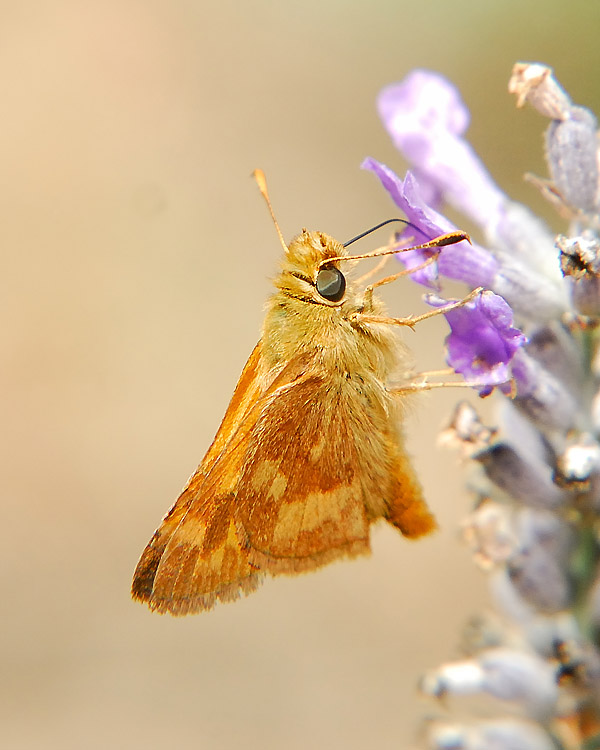
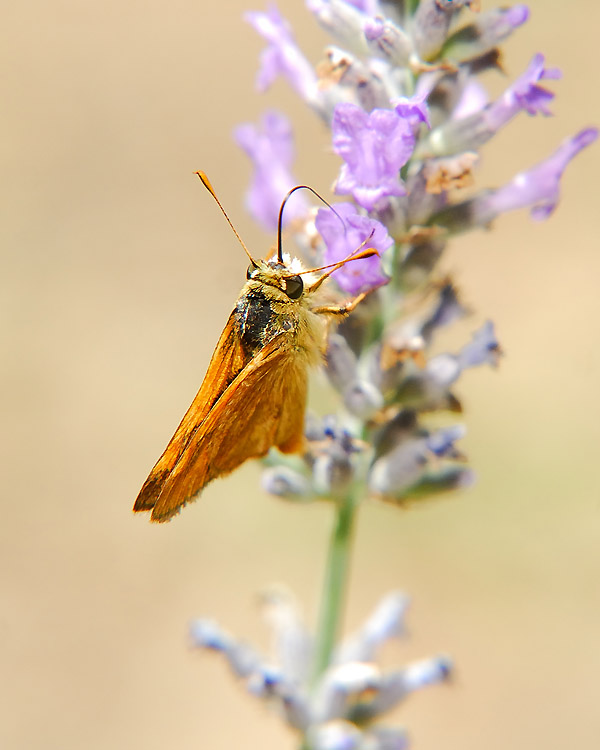
At this same time last summer little was in bloom, except for some native asters, as most of our flowering plants were California natives that settle into their summer dormancy by late August.
However, starting this spring, we’ve slowly begun to add a few well-behaved non-native species to the cultivated areas, as nectar and pollen resources, including some late-blooming hybrid sages, lavender, Coreopsis and Rudbeckia species. The butterflies at least seem to be appreciating our efforts.
Unfortunately, the terrain here is rather treacherous, so running around with one’s eye attached to the viewfinder chasing butterflies can be a rather hazardous undertaking. As such, my butterfly photo collection has been sparse up to this point, and the majority of the images quite blurry.
Yesterday though I was fortunate to find this group of Woodland Skippers nectaring on some of our Lavandula intermedia ‘Provence’ plants that are still in bloom.
Yesterday though I was fortunate to find this group of Woodland Skippers nectaring on some of our Lavandula intermedia ‘Provence’ plants that are still in bloom.
Woodland Skippers are members of the Hesperiidae family of butterflies, and perhaps the most common species of Skipper to be found in the western states[1]. They’re sympatric with, and very similar in appearance to, the Rural Skipper (Ochlodes agricola). However, Woodland Skippers are generally in flight later in the season than Rural Skippers, most commonly sighted between July and October, with their peak flight activity in late August to early September [2].
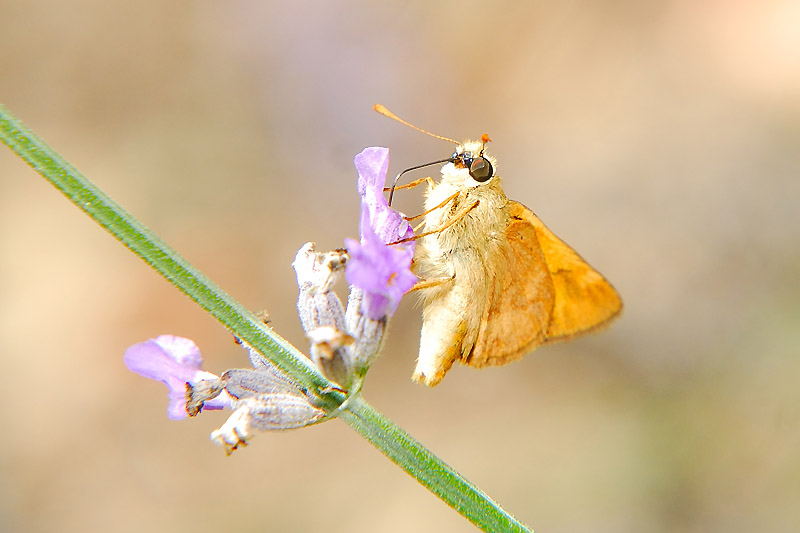
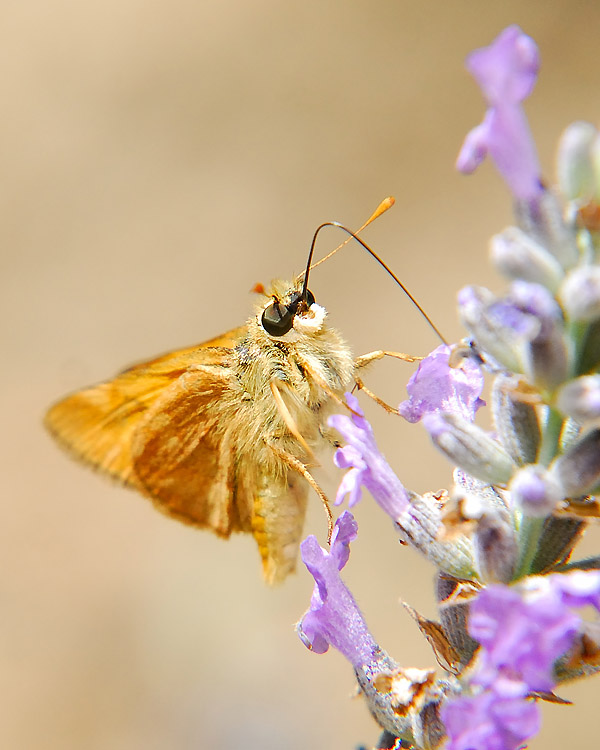

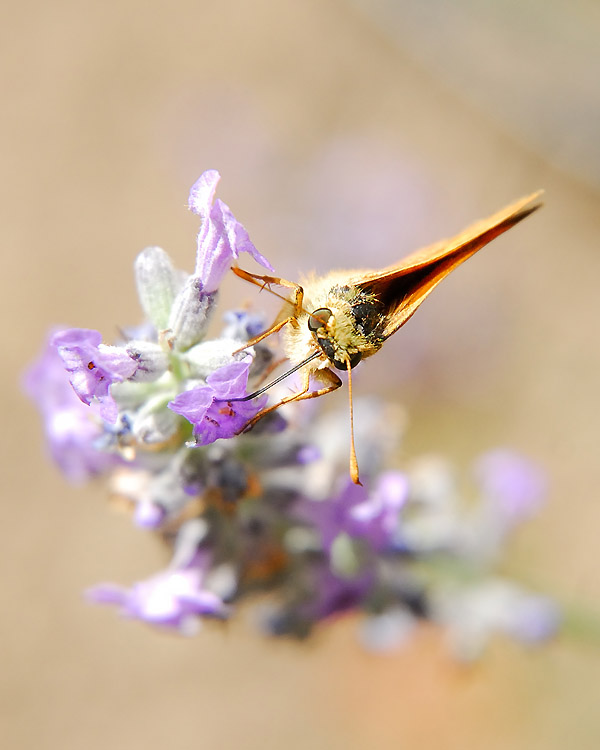
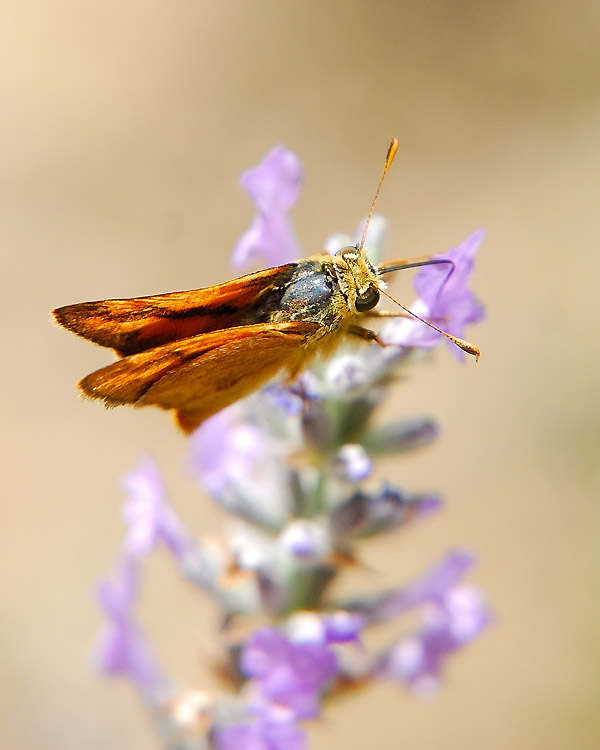
These skippers, unlike their counterparts, are found in a more diverse array of habitats, including chaparral, shrub-steppe, and riparian woodland, however, like the Rural Skipper, they tend to prefer to avoid urbanized areas.
The Woodland Skipper’s preferred habitat is moist woodland clearings. This year we seem to meet that criteria as our late spring rainfall, and cool summer temperatures, has allowed both creeks on the property to remain flowing all season.
Woodland Skippers typically frequent undisturbed sites. Although we have cleared some small areas on the property over the last few years, we’ve left the vast majority of the woodland untouched.
We have at least two preferred native nectaring plants on the property, including native asters (Symphyotrichum chilense), which are in bloom now, and Coyote Brush (Baccharis pilularis), which is just about bloom. However, they are quite enchanted with the lavender blossoms too.
The larval food sources for this species aren’t specifically known, but are believed to be perennial grasses[3].
Identifying Skippers can be challenging, but to tell if you’re looking at a member of the Skipper family, look at the tip of their antennae. Skippers have a unique physical trait. The ‘club’ section on the distal antenna hooks backwards, resembling the tip of a crochet hook.
With so many skippers nectaring on the lavender blossoms, I suppose it was inevitable that someone else would be found dining in the same area.
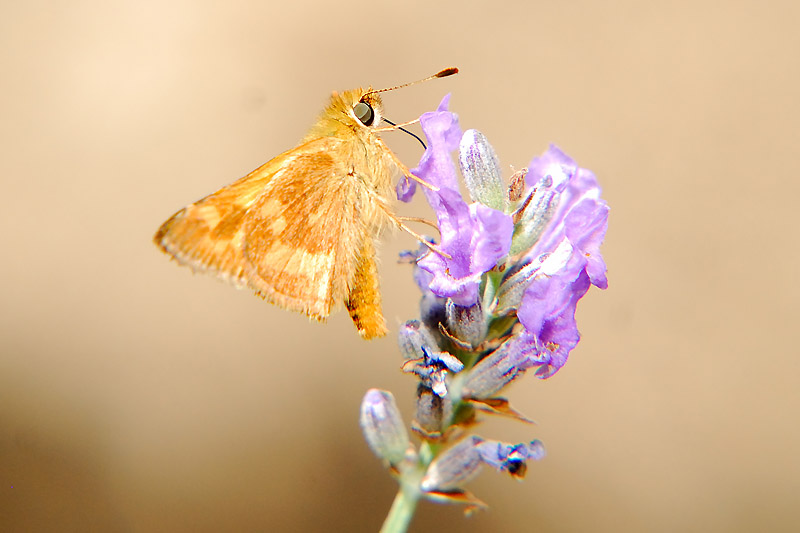

As I moved through the lavender bed, trying to keep up with these frenetic little butterflies, I suddenly discovered yet another crab spider lurking in the garden, but this time, instead of a honey bee, she had a Skipper firmly in her grasp.
It seems like quite an ambitious meal for a spider of this size.
As always here at Curbstone Valley, it seems that where there is plentiful prey, predators abound, but that’s all part of the balance of life here on the farm.
Although this Skipper met its demise, it’s been very gratifying to watch as more beneficial insects gradually call the farm home. With fall planting season just around the corner, we can’t wait to add even more plants to the gardens. I wonder who we’ll find lurking in the gardens next year?
—————-
[1] Glassberg, Jeffrey. 2001. Butterflies through Binoculars: The West : A Field Guide to the Butterflies of Western North America. Oxford University Press. p. 272
[2] Tilden, J. W. 1965. Butterflies of the San Francisco Bay Region. University of California Press. p. 80
[3] Garth, J.S., and Tilden, J. W. 1986. California Butterflies. University of California Press. p. 157.

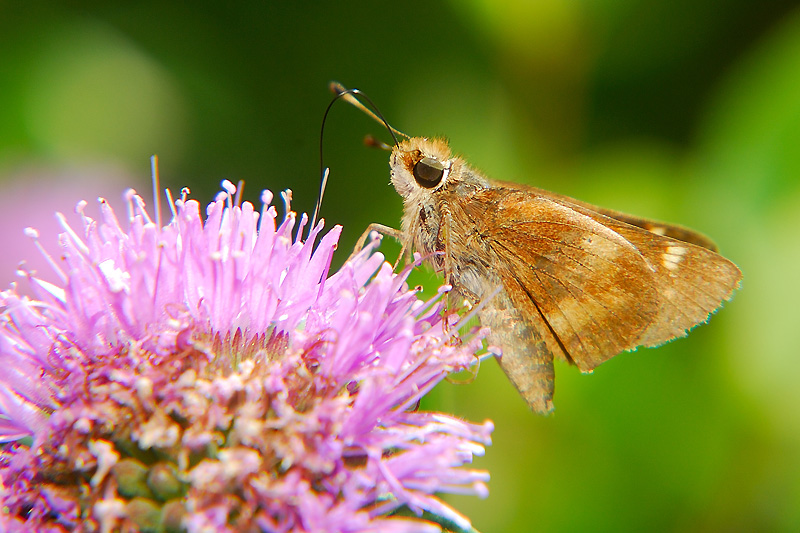
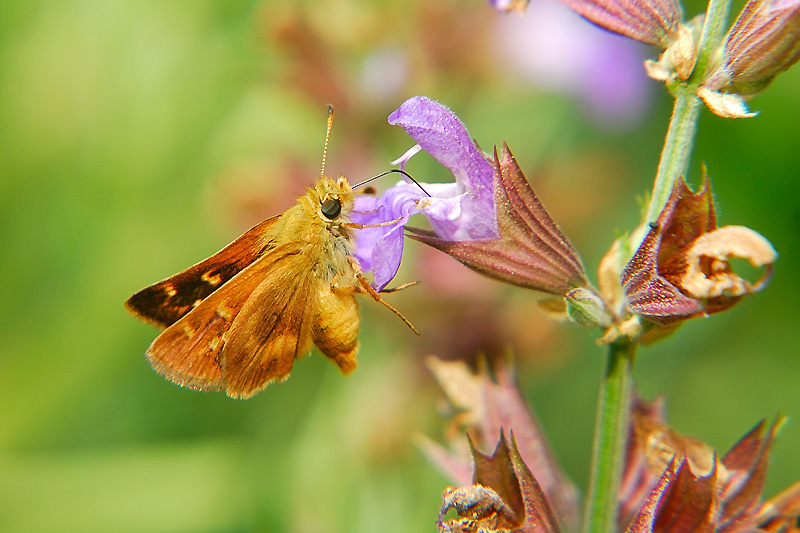

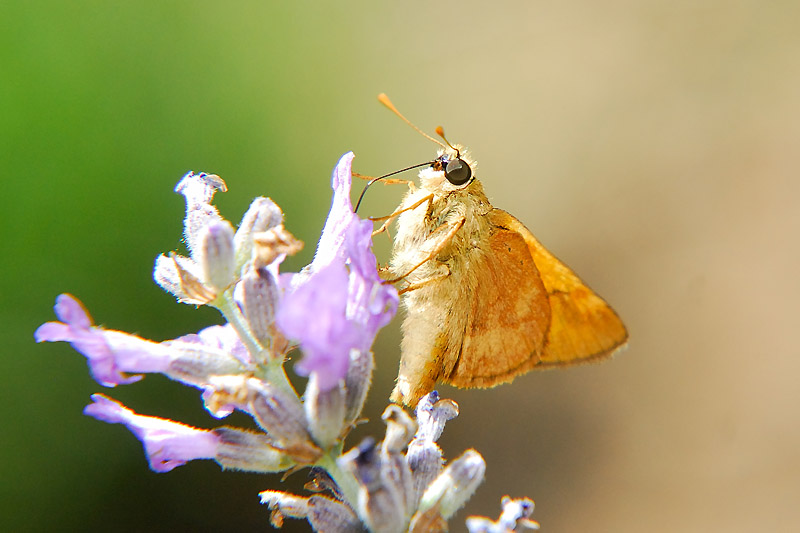
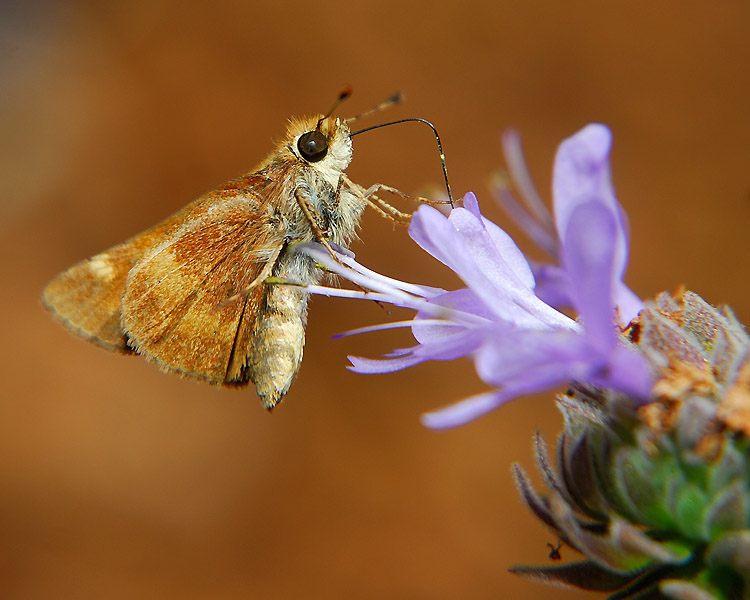
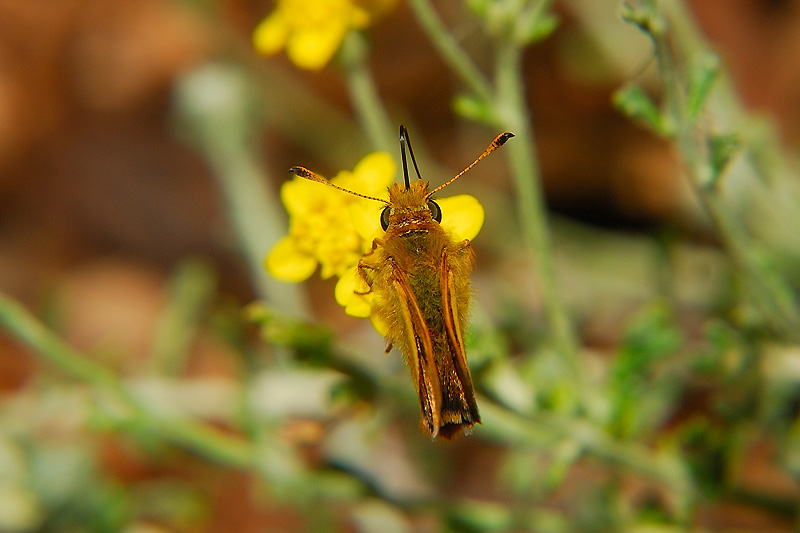
what a great pollinator and you captured it beautifully on the lavender
Thank you Donna. I don’t think it would have been possible if there weren’t so many of them zipping about 😉
Wow what great photos! Drama, as well as beauty and detail! I’ve been noticing a lot of skippers on my Verbena lilacena ‘De la Mina’ – thanks for the tip about the crochet hook antennae! Not sure if they are woodland ones or not – have to go look!
My ‘De la Mina’ isn’t blooming much at the moment, I think it’s getting too much shade from the enormous tomatillos in the raised bed in front of it. We have a few Skippers common to our area this time of year, but it does seem the Woodland Skipper is abundant at the moment.
Awesome photos of what I’m sure is a hard-to-photograph subject. I will remember the hooked antennae clue. Love your list of visitors at the beginning… butterflies go by the most wonderful names!
My goal is to have photographs to go with that list at some point. We have one snapshot of the Lorquin’s Admiral, but it was a cell phone image, and fuzzy. I can only seem to get really close to them when I don’t have my good camera in hand 😛
A fabulous collection of lustily gorging butterflies
They really were feasting! It was amusing to watch the Skippers and honey bees jostling on the flowers, occasionally knocking each other off. 😉
What great pictures! I’ve noticed a lot of Skippers here too recently. They always love the lavender. This time of year seems to be when we see them, wonder if they are the same kind? They look like it.
We also have had Lorquin’s Admirals here this summer, first time I’ve ever seen one. Randy id’d a picture of it since I had no idea what it was. Maybe the butterflies are liking this heat?
That’s funny, I sent Randy our fuzzy cell-phone pic of a Lorquin on a tomato plant. Our Lorquin was a little different, with a row of tiny orange dots on the hind-wing, so I wasn’t confident in my ID at first, so sent it to Randy for confirmation. I do think the butterflies are grateful for the heat. I noticed as soon as the lavender fell into shade in the late afternoon that all the Skippers suddenly disappeared. They do seem to like the warm sunshine.
Skippers, I’ll be watching for them!
Speaking of being overrun, does anyone else on the Central coast noticed an unusually high flea population this year? Our Vet says that everyone’s got it bad, she’s heard it from most of her patients. I don’t get it, considering that we have two indoor cats and a tidy house…grrrr!
Note to self: Continue with monthly Frontline and lots of vacuuming…
It has been bad this year, and it was pretty bad for ticks too in late spring/early summer. I’m sure all of our abundant rainfall, and mild weather this last winter and spring didn’t help. The creeks may still be flowing, but the ticks and fleas are also exploding! 😉
Wow! Clare, you get the best photos of insects! I also read the crab spider post, especially because we happen to have the giant crab spider now and then,…in the house. Amazing photos on both these posts.
When you live in the country there are lots of insects but my favorites, like most folks are the butterflies. I’m so thrilled to be seeing more varieties here as well, but i’ll have to work on getting more photos if I can. 🙂
I love seeing the abundance of dragonflies this year too. I’ve seen at least three different species this year, but darn it if they’re not even more difficult to capture with a lens 😉 Maybe I’ll get lucky. I do wonder if the fact the creeks are still running are helping both the butterfly and dragonfly populations here this spring.
What great photos! Can’t help but feel for the poor caught skipper in the crab spider’s grasp, but such is the way of nature. Finding butterflies in the garden is always so satisfying to me. It makes me feel I’ve done something right.
I’d never seen a crab spider before moving here. This year though, perhaps because I now know what they are, I’ve been seeing a lot of them. I’m still always somewhat in awe when I find one with prey, as it’s usually a lot larger than the spider. That said though, who knew there was so much danger lurking among the flowers for the bees and butterflies? 😯
Clare,
Nice photos and excellent post. I think I have photographed this species, not on this computer though. Here in the eastern US we have the Leonard’s Skipper it is the last butterfly to emerge for the season, very uncommon or rare though.
I looked at the Leonard’s Skipper, it’s remarkably similar in pattern, just more intensely colored under the wings. I’ve certainly come to appreciate, after looking up this one, how challenging these tiny butterflies can be to ID!
Clare, these are really nice photos, I like the soft, light background in them. The spider drama was pretty unique too. He is quite ambitious, I hope he finishes his meal with no waste.
I did not know the hook at the end of the antennae, and will have to catch that next time I see them. I get them quite a bit in my garden on the Russian Sage and asters. The lavender is a plant I never noticed them feeding upon.
That soft light background is our sandy soil, but I agree, it did make for a pleasing color in the background of the pictures (I learned sometime ago never to mulch lavender…oops). I’ve considered adding Russian Sage to the garden, as I know a number of pollinators enjoy it, I’m just not sure how well it would do here. I’d probably have to find just the right spot, as it gets quite hot on our dry sandy slopes in summer.
Such fabulous photos … even if it’s a little treacherous getting them. It must be an absolute joy to see so many beautiful butterflies out and about in your maturing garden. As you say, you are definitely doing something right. The little Woodland Skipper is a real cutie … and your captures were great.
I’m happy to report no black eyes getting these photos (I did once fall head first down our slope, and a shovel broke my fall). I’ve learned to respect the terrain here 😉 Sometimes I wish I could fast forward 10 years and see how the garden turns out once everything fills in, it still looks a bit sparse at the moment, but that’s a good excuse to plant more flowers!
Dear Clare, I always enjoy your postings, but this one is my favorite so far. A great joy of gardening for me is to see the wonderful wildlife it brings into my life. You have captured this sentiment perfectly here. P. x
It’s one of my favorite parts too, seeing the wildlife that takes refuge in the garden, whether it’s salamanders, or lizards, butterflies, or native bees. It’s a large part of my motivation to be in the garden!
I am seeing lots of skippers in my garden too! They are really fun to watch! I love your set of photos with the crab spider. Sad for the butterfly but everyone has to eat 🙂
They are fun to watch, albeit a little exhausting, they’re so energetic! No wonder they were eating so much 😛
Early in the summer we had a plethora of tiger swallowtails. It was a good year for them. Then it got hot–really hot and the butterflies disappeared. Last year we had a nice number of the black swallowtails, painted ladies, and fritillaries and a couple of monarchs. This year the butterflies are quite sparse. I did see one painted lady on a cosmos and monarch wandered through. I didn’t plant many zinnias this year, which really attract the butterflies, but I also have a heallthy herd (if they travel in herds) of the nasty ambush bug that sits in wait for any other insect. Unlike the little crab spider that does not seem too prolific in your garden, the ambush bugs sit 2, 3, 4 to a flowers. They are even on dill, where the black swallowtail like to lay eggs. So I am wondering if the these nasty critters are interfering with my butterfly population? As you add to your garden to attract butterflies, I hope you share your list of plants. Your pictures are always quite amazing.
I only occasionally sight a swallowtail here, but I’d like to encourage them more. I see few monarchs though, which is ironic as we’re just a few miles from Natural Bridges, a popular wintering area for them. Clearly I need to plant more milkweed! I haven’t noticed ambush bugs on the flowers specifically, but I did notice some insect eggs on some fennel earlier in the year, but they were consumed before they hatched, so I’m not sure what they were, or who ate them!
Hi Clare,
Lovely photos, I do wish we had more skippers here but I can’t really complain as I had more than previous years!
They’re beautiful butterflies and I do love their hooked little antennae and their weird wings; they almost look like moths rather than Butterflies.
They really do look quite moth like, with their broad abdomens, and relatively muted colors. They’re much more charming and fun to watch though.
Such tender images. And don’t the Skippers make a gorgeous colour contrast with the lavender hues? Glad the well-behaved non natives are doing the trick – diversity in the garden no less.
I’m actually enjoying branching out a little. The focus will still be native plants in the garden, but if nothing else, our honey bees have taught me that natives alone are too restrictive in our climate, and don’t provide enough food in the months leading up to winter. An excuse to plant more flowers…oh dear 😛
I love the photographs! I wish I had more butterflies in my garden. Plenty of bees and wasps and even dragonflies, but sadly, not many butterflies. I’m going to plant more “butterfly attractors” this season.
Plant choices certainly make a difference, at least they have here. I’d suggest starting by making a list of known butterfly species in your area, and seeing if you can plant some of the larval host plant species in the garden. The plants the larvae depend on for shelter and growth.
I hate to see a skipper caught in the clutches of a spider but on the other hand I always appreciate a fine dining review. Love the images you captured
I agree, always sad to see, but all part of the cycle of life. Today I found a jumping spider with another butterfly in its clutches. It’s a rough world out there for butterflies!
Such beautiful photos of the charming little skipper! We see quite a few skippers in our garden but I haven’t become skilled at identifying them.
They are very difficult to identify. I was able to find out which species are most common to this area, so that definitely helped narrow it down, but the differences in markings between some species is very subtle!
Am I the only one that sees a face in the first crab spider photo? The spider seems to be smiling! Your photos are really nice. Now that I know to look for a crochet hook antenna, maybe I can identify skippers in my own garden.
It’s a little difficult to tell facial features, I really need a better macro lens for this camera. I do think I see an eyeball in the second one though!
Thanks for the tips in IDing a skipper. I know how to differentiate a moth from a butterfly with the antennae, but with the crochet hook pointing backwards, i haven’t noticed that. BTW, i smiled at your comment in Helenex’s post about adventitious roots. You said the tomatoes have totipotent cells. I love that, as very few know these technical terms. I love to be reminded of things already in my head, but somehow not used. Now they come pouring e.g. totipotency, geotropism, photothropic, hahaha. I miss my physio.
LOL, every once in a while, as I paid for them, I feel obligated to bust out one of my $20 words 😛 Plants are remarkable that way though, and I couldn’t think of a better, equally descriptive word! 😉